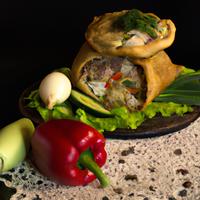
1 serving (100 grams) contains 300 calories, 5.0 grams of protein, 15.0 grams of fat, and 35.0 grams of carbohydrates.

Log this food in SnapCalorie

Nutrition Information
Calories |
714.3 | ||
|---|---|---|---|
% Daily Value* |
|||
| Total Fat | 35.7 g | 45% | |
| Saturated Fat | 19.0 g | 95% | |
| Polyunsaturated Fat | 0 g | ||
| Cholesterol | 71.4 mg | 23% | |
| Sodium | 476.2 mg | 20% | |
| Total Carbohydrates | 83.3 g | 30% | |
| Dietary Fiber | 2.4 g | 8% | |
| Sugars | 35.7 g | ||
| protein | 11.9 g | 23% | |
| Vitamin D | 0 mcg | 0% | |
| Calcium | 119.0 mg | 9% | |
| Iron | 2.4 mg | 13% | |
| Potassium | 238.1 mg | 5% | |
* Percent Daily Values are based on a 2,000 calorie diet. Your daily values may be higher or lower depending on your calorie needs.
Food Attributes
Source of Calories
About Sochnik
Sochnik is a traditional Russian pastry made of soft, buttery dough filled with a sweet, creamy mixture—typically made from farmer’s cheese, sugar, and occasionally eggs or sour cream. Its semi-circle shape and golden exterior make it recognizable and inviting. The farmer’s cheese is a notable highlight, offering protein and calcium while being lower in fat than cream-based fillings. However, the pastry itself can be calorie-dense due to the inclusion of refined flour, sugar, and butter, making it more of an occasional indulgence than a health-focused snack. Sochnik’s origins are rooted in Eastern European baking traditions, often enjoyed alongside tea or as a dessert. While its nutritional profile includes some beneficial elements from dairy, moderation is key, as its high sugar and fat content may outweigh the health benefits for daily consumption.



